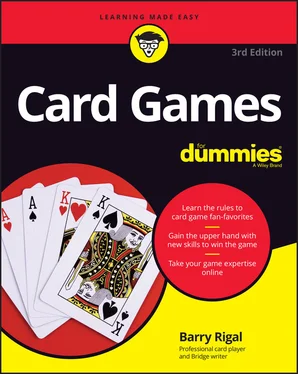 A less demanding version of the game allows you to discard anything you like to your waste piles. Of course, if you play this variation, you never get stuck for a move, but it does cut down on the opportunities for spite and malice!
A less demanding version of the game allows you to discard anything you like to your waste piles. Of course, if you play this variation, you never get stuck for a move, but it does cut down on the opportunities for spite and malice!
If both players can’t move, you collect all the waste piles and hands, shuffle them up, and redeal new hands. You leave the reserve piles as they are.
Spite and Malice is an excellent competitive game; you have to watch your own cards, plan how best to get rid of them, figure out how to use up your reserve pile, and strategize how to discard onto your waste pile. But equally important is spoiling your opponent’s strategy, blocking their reserve pile, preventing them playing from their waste piles by taking the foundation piles past convenient numbers, and generally making yourself a nuisance.
 Try to keep your waste piles as empty as possible; within a single pile, you may want to duplicate cards to preserve flexibility. Occasionally, however, you can see that by (for example) duplicating jacks in a single pile, you may prevent yourself from having access to the queen below the jack. If your opponent has a queen on the reserve pile, that duplication is a very bad idea.
Try to keep your waste piles as empty as possible; within a single pile, you may want to duplicate cards to preserve flexibility. Occasionally, however, you can see that by (for example) duplicating jacks in a single pile, you may prevent yourself from having access to the queen below the jack. If your opponent has a queen on the reserve pile, that duplication is a very bad idea.
The game ends when one player gets rid of their reserve pile, and the other player records how many cards they have left. The game is ideal for an ongoing struggle (say 20 years or so), as is the case for two of my friends who’ve been playing it for that long.
The Web offers a wide variety of sites for the Solitaire enthusiast. You can find tons of Solitaire games to play online for free; for example, you can go www.247solitaire.com .
Chapter 3
IN THIS CHAPTER
 Playing games that improve memory and concentration
Playing games that improve memory and concentration
 Working on speed and coordination
Working on speed and coordination
 Discovering new games to play with your friends
Discovering new games to play with your friends
Just because this chapter refers to children, adults should not pass it by and ignore the contents. The games in this chapter are suitable for a range of players — younger players, new players, adults playing with younger players, or players who just like fast-action card games that are easy to pick up and fun to play. (All the most enthusiastic Spit players I have met have been adults: It is more a question of attitude than age.) So, whoever you are, you sure to find a game in this chapter to enjoy.
Additionally, several games in other chapters of this book are just as suitable for children as the ones described here. Eights, also known as Crazy Eights ( Chapter 6), President ( Chapter 17), and Whist ( Chapter 8) come to mind.
Beggar My Neighbor, also known as Beat Your Neighbor Out of Doors and Strip Jack Naked, requires no strategy or planning at all, making it a great game for kids and for social situations. The objective of the game is to win all the cards from the other players.
 To play Beggar My Neighbor, you need the following:
To play Beggar My Neighbor, you need the following:
Two to six players: You can play with more than six players in a pinch.
A standard deck of 52 cards: With four or more players, add a second deck of cards. A great advantage of this game is that you don’t really need a complete deck of cards — a card or two gone missing is almost irrelevant. Don’t forget to remove the jokers!
To begin, one player deals out the whole deck in a clockwise rotation, dealing the cards face-down and one at a time so that each player gets about the same number of cards. You don’t look at your cards; you form them into a neat pile, face-down in front of you.
The player to the left of the dealer turns over the top card from their pile and places it in the center of the table (or floor, if you want to sprawl out).
Different things can happen now, depending on what card the first player turns over:
If the value of the card is between 2 and 10, it has no special significance, and the play goes on to the next player.
If the card is a court card (an ace, king, queen, or jack), the game becomes a little more exciting. The next player has to pay a forfeit, meaning that they has to turn over some of their cards and place them onto the central pile:If the first card up is an ace, the second player must turn over four cards one by one onto the middle pile.If the first card is a king, the next player has to pay three cards.If the first card is a queen, the second player must pay two cards.If the first card is a jack, the second player turns up only one card.
If all the cards the second player turns over are between 2 and 10, the first player who turned over the court card takes up the whole pile and puts it under their personal pile, face-down. If the second player turns over another court card during the course of the forfeit, they pay the debt off, and the second player doesn’t have to turn over any more cards. Instead, the third player must pay the forfeit dictated by the second court card and either turn over a court card in the process, or allow the second player to pick up the whole central pile if no court card comes.
When you have no more cards left, you’re out, and the game continues without you. If you run out of cards in the middle of paying a forfeit for an ace, king, or queen, you are out of the game. In games of more than two players, the previous player picks up the pile of cards, and the next player starts afresh. The last player in the game — the one who accumulates the whole deck — wins.
 Your success at Beggar My Neighbor depends on the luck of the draw; if you get a good smattering of court cards, you have a good chance to win. If someone feels bad because they lost, you may want to remind them of the luck factor. But don’t forget to congratulate them if they win!
Your success at Beggar My Neighbor depends on the luck of the draw; if you get a good smattering of court cards, you have a good chance to win. If someone feels bad because they lost, you may want to remind them of the luck factor. But don’t forget to congratulate them if they win!
 Because Beggar My Neighbor can go on for a long time — making it ideal for long car journeys, waiting for planes, or similar situations — you can agree that the player with the most cards at a certain predefined time is the winner.
Because Beggar My Neighbor can go on for a long time — making it ideal for long car journeys, waiting for planes, or similar situations — you can agree that the player with the most cards at a certain predefined time is the winner.
These days, most children seem to be born with a remote or video-game controller in their hands. However, some children are lucky enough to receive decks of cards when they’re young (as was the case with me).
Teaching children how to play cards is fun — both for them and for you! Children get an opportunity to interact with others, revel in the challenge of a game, and enjoy a sense of mastery. Card games also foster a strong sense of belonging and a connection to the family or social group.
Читать дальше

 A less demanding version of the game allows you to discard anything you like to your waste piles. Of course, if you play this variation, you never get stuck for a move, but it does cut down on the opportunities for spite and malice!
A less demanding version of the game allows you to discard anything you like to your waste piles. Of course, if you play this variation, you never get stuck for a move, but it does cut down on the opportunities for spite and malice! Try to keep your waste piles as empty as possible; within a single pile, you may want to duplicate cards to preserve flexibility. Occasionally, however, you can see that by (for example) duplicating jacks in a single pile, you may prevent yourself from having access to the queen below the jack. If your opponent has a queen on the reserve pile, that duplication is a very bad idea.
Try to keep your waste piles as empty as possible; within a single pile, you may want to duplicate cards to preserve flexibility. Occasionally, however, you can see that by (for example) duplicating jacks in a single pile, you may prevent yourself from having access to the queen below the jack. If your opponent has a queen on the reserve pile, that duplication is a very bad idea. Playing games that improve memory and concentration
Playing games that improve memory and concentration To play Beggar My Neighbor, you need the following:
To play Beggar My Neighbor, you need the following: Your success at Beggar My Neighbor depends on the luck of the draw; if you get a good smattering of court cards, you have a good chance to win. If someone feels bad because they lost, you may want to remind them of the luck factor. But don’t forget to congratulate them if they win!
Your success at Beggar My Neighbor depends on the luck of the draw; if you get a good smattering of court cards, you have a good chance to win. If someone feels bad because they lost, you may want to remind them of the luck factor. But don’t forget to congratulate them if they win!










